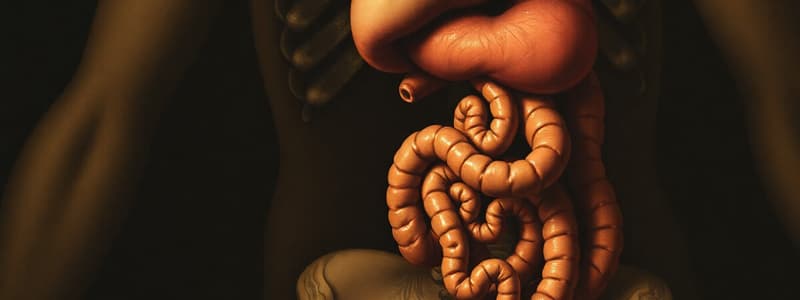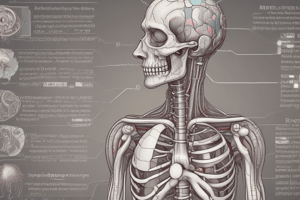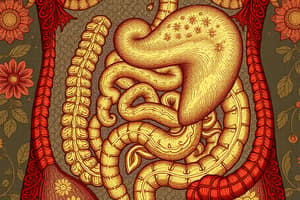Podcast
Questions and Answers
Which of the following is the primary function of the digestive system?
Which of the following is the primary function of the digestive system?
- Transporting oxygen throughout the body
- Regulating body temperature
- Filtering waste products from the blood
- Breaking down food into absorbable molecules (correct)
The large intestine is the primary site for nutrient absorption.
The large intestine is the primary site for nutrient absorption.
False (B)
What enzyme, present in saliva, initiates the chemical digestion of starch?
What enzyme, present in saliva, initiates the chemical digestion of starch?
amylase
The wave-like muscle contractions that propel food through the digestive tract are called ______.
The wave-like muscle contractions that propel food through the digestive tract are called ______.
Match the following enzymes with their primary substrates:
Match the following enzymes with their primary substrates:
What is the role of hydrochloric acid (HCl) in the stomach?
What is the role of hydrochloric acid (HCl) in the stomach?
The gallbladder produces bile.
The gallbladder produces bile.
What is the name given to the mixture of partially digested food and gastric secretions in the stomach?
What is the name given to the mixture of partially digested food and gastric secretions in the stomach?
The lower esophageal sphincter (LES) prevents stomach contents from refluxing back into the ______.
The lower esophageal sphincter (LES) prevents stomach contents from refluxing back into the ______.
Match the following organs with their primary digestive function:
Match the following organs with their primary digestive function:
Which substance emulsifies fats in the small intestine, aiding in their digestion?
Which substance emulsifies fats in the small intestine, aiding in their digestion?
Mechanical digestion only occurs in the mouth.
Mechanical digestion only occurs in the mouth.
Name the three sections of the small intestine in order.
Name the three sections of the small intestine in order.
The enzyme that breaks down proteins into smaller peptides in the stomach is called ______.
The enzyme that breaks down proteins into smaller peptides in the stomach is called ______.
Match the following digestive hormones with their primary functions:
Match the following digestive hormones with their primary functions:
Which of the following is a common symptom of Gastroesophageal Reflux Disease (GERD)?
Which of the following is a common symptom of Gastroesophageal Reflux Disease (GERD)?
Irritable Bowel Syndrome (IBS) involves chronic inflammation of the digestive tract.
Irritable Bowel Syndrome (IBS) involves chronic inflammation of the digestive tract.
What is the autoimmune reaction triggered by gluten in individuals with celiac disease?
What is the autoimmune reaction triggered by gluten in individuals with celiac disease?
Bicarbonate ions from the pancreas neutralize ______ from the stomach as chyme enters the small intestine.
Bicarbonate ions from the pancreas neutralize ______ from the stomach as chyme enters the small intestine.
Match the following absorption mechanisms with their descriptions:
Match the following absorption mechanisms with their descriptions:
Flashcards
Digestive System
Digestive System
Breaks down food into smaller molecules for energy, growth, and repair.
Ingestion
Ingestion
Taking food into the body through the mouth.
Digestion
Digestion
Breaking down food into smaller molecules, both mechanically and chemically.
Absorption
Absorption
Signup and view all the flashcards
Elimination
Elimination
Signup and view all the flashcards
Alimentary Canal
Alimentary Canal
Signup and view all the flashcards
Accessory Organs
Accessory Organs
Signup and view all the flashcards
Mouth
Mouth
Signup and view all the flashcards
Amylase
Amylase
Signup and view all the flashcards
Esophagus
Esophagus
Signup and view all the flashcards
Peristalsis
Peristalsis
Signup and view all the flashcards
Stomach
Stomach
Signup and view all the flashcards
Hydrochloric Acid (HCl)
Hydrochloric Acid (HCl)
Signup and view all the flashcards
Pepsin
Pepsin
Signup and view all the flashcards
Small Intestine
Small Intestine
Signup and view all the flashcards
Bile
Bile
Signup and view all the flashcards
Large Intestine
Large Intestine
Signup and view all the flashcards
Liver
Liver
Signup and view all the flashcards
Gallbladder
Gallbladder
Signup and view all the flashcards
Pancreas
Pancreas
Signup and view all the flashcards
Study Notes
- The digestive system breaks down food into smaller molecules.
- The smaller molecules are absorbed and used for energy, growth, and repair.
- The digestive system consists of a series of organs working together.
Main Functions
- Ingestion occurs when food is taken into the body through the mouth.
- Digestion breaks down food into smaller molecules using mechanical and chemical processes.
- Absorption transports digested molecules from the digestive tract into the bloodstream.
- Elimination removes undigested and unabsorbed material from the body as feces.
Organs of the Digestive System
- The digestive system has two main components.
- The alimentary canal (or digestive tract) is one component.
- Accessory organs are the second component.
- The alimentary canal is a continuous tube from the mouth to the anus.
- Accessory organs aid digestion but are not part of the alimentary canal.
Mouth
- The mouth is the entry point for food.
- Mechanical digestion starts in the mouth with chewing (mastication).
- Chewing increases the surface area of food.
- Saliva, secreted by salivary glands, begins chemical digestion.
- Saliva contains amylase, which breaks down starch into sugars.
- The tongue manipulates food, forming a bolus.
- A bolus is a soft, rounded mass that is easy to swallow.
Esophagus
- The esophagus connects the pharynx (throat) to the stomach.
- The esophagus transports the bolus to the stomach via peristalsis.
- Peristalsis involves wave-like muscle contractions that propel food along the digestive tract.
- The lower esophageal sphincter (LES) prevents stomach contents from refluxing back into the esophagus.
Stomach
- The stomach is a J-shaped organ that mixes and stores food.
- Gastric juice, containing hydrochloric acid (HCl) and pepsin, is secreted by the stomach.
- HCl lowers the pH of the stomach, creating an acidic environment.
- The acidic environment kills bacteria and denatures proteins.
- Pepsin is a protease that breaks down proteins into smaller peptides.
- The stomach’s muscular walls churn and mix food with gastric juice, forming chyme.
- The pyloric sphincter controls the release of chyme into the small intestine.
Small Intestine
- The small intestine is the primary site of nutrient absorption.
- The small intestine consists of the duodenum, jejunum, and ileum.
- The duodenum receives chyme from the stomach.
- The duodenum receives digestive enzymes from the pancreas.
- The duodenum receives bile from the liver and gallbladder.
- The pancreas secretes pancreatic juice containing enzymes that digest carbohydrates, proteins, and fats.
- Bile, produced by the liver and stored in the gallbladder, emulsifies fats, which aids digestion.
- The jejunum and ileum absorb nutrients into the bloodstream.
- The inner lining of the small intestine is highly folded and covered with villi and microvilli.
- Villi and microvilli increase the surface area for absorption.
Large Intestine
- The large intestine absorbs water and electrolytes from undigested material.
- The large intestine consists of the cecum, colon, rectum, and anus.
- The cecum is a pouch that receives waste material from the small intestine.
- The colon compacts and stores undigested material, creating feces.
- The rectum stores feces until they are eliminated through the anus.
- The large intestine contains a diverse community of gut bacteria that aid digestion and immunity.
Accessory Organs
- The liver produces bile, aiding fat digestion and absorption, and plays a role in detoxification and metabolism.
- The gallbladder stores and concentrates bile produced by the liver, releasing it into the small intestine.
- The pancreas secretes pancreatic juice containing digestive enzymes and bicarbonate ions to neutralize stomach acid.
Digestive Processes
- Mechanical digestion involves the physical breakdown of food into smaller pieces, including chewing and churning.
- Chemical digestion involves the enzymatic breakdown of food into smaller molecules.
- Enzymes like amylase, pepsin, and lipase break down carbohydrates, proteins, and fats, respectively.
Absorption Mechanisms
- Nutrients are absorbed into the bloodstream through active transport, passive transport, facilitated diffusion, and endocytosis.
- Active transport requires energy to move nutrients against their concentration gradient.
- Passive transport allows nutrients to move down their concentration gradient without energy.
- Facilitated diffusion involves nutrients moving down their concentration gradient with the help of membrane proteins.
- Endocytosis involves the cell membrane engulfing larger molecules.
Regulation of Digestion
- Hormonal and nervous mechanisms regulate the digestive system.
- Hormones like gastrin, secretin, and cholecystokinin (CCK) regulate gastric secretion, pancreatic enzyme release, and gallbladder contraction.
- The enteric nervous system controls motility and secretion within the digestive tract.
- The autonomic nervous system (parasympathetic and sympathetic branches) influences digestive function.
Common Digestive Disorders
- Gastroesophageal Reflux Disease (GERD) occurs when stomach acid refluxes into the esophagus, causing heartburn and inflammation.
- Peptic ulcers are sores that develop in the lining of the stomach or small intestine.
- Peptic ulcers are often due to bacterial infection (Helicobacter pylori) or prolonged use of NSAIDs.
- Inflammatory Bowel Disease (IBD) involves chronic inflammation of the digestive tract, including Crohn's disease and ulcerative colitis.
- Irritable Bowel Syndrome (IBS) affects the large intestine, causing abdominal pain, bloating, and changes in bowel habits.
- Celiac Disease is an autoimmune disorder triggered by gluten, leading to damage of the small intestine and malabsorption of nutrients.
- Gallstones are hard deposits that form in the gallbladder, causing pain and inflammation.
Studying That Suits You
Use AI to generate personalized quizzes and flashcards to suit your learning preferences.




